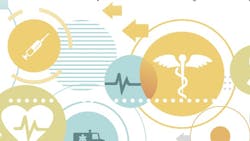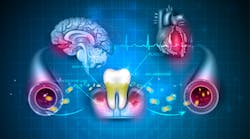Practical ways to implement oral-systemic wellness protocols in your daily practice
Integrating oral-systemic connections into your practice philosophy is vital to being a relevant dental provider for today’s patients. We live in a world where medical science provides abundant evidence to adapt our protocols to this well-documented data.
So, how do we integrate oral-systemic wellness protocols into our practices without scaring our patients and throwing ourselves under the proverbial bus? Here are six ways to integrate oral wellness conversations and protocols into your practice.
Develop a learning culture for your team
Successful teams make the time to meet, calibrate, and collaborate about the practice's mission. Encouraging team members to be curious can foster a positive culture. Team leaders with a learning culture are 30% more likely to be leaders in their industry.1
Schedule a team meeting, and a few weeks before the meeting, assign each team member an oral-systemic topic to create a short presentation on five facts for each topic. Start by sharing the prevalence of periodontal disease and caries with your team. Cases of periodontitis and dental caries are high in the US. Almost 42% of the adult population have some form of periodontal disease.2
Nearly 90% of adults ages 20 to 64 have had dental caries. In addition, approximately 2% of adults ages 20 to 64 have no teeth.3 These statistics demonstrate that patients need help! Your team's shared learning will advance their knowledge base, then you can brainstorm ideas for educating your patients.
This exercise may be met with team pushback. But when your team educates themselves on these connections, they’ll realize the opportunity for health-care professionals to improve the value of their care. These activities and conversations can spark passion with providers and ignite a newfound purpose for burned out clinicians. In addition, team education can unite the clinical and business teams to share information with patients and show a well-calibrated team.
Meet your patients where they are
Now that your team has knowledge of the oral-systemic connection, the next step is moving this knowledge into action. Develop a game plan on how to share this education with patients and do some role-playing to get your team comfortable having these conversations. The Global Health Thinking Report states, "Surprisingly, globally, only 21% of patients on average thought there was a link between overall life expectancy and dental health."4
Dental professionals are tasked with helping patients understand the science behind our treatment plans in a way they can understand. So, we must find a way to meet patients where they are based on their knowledge and communication style.
Find topics they’re already aware of and make the connection to oral health, which is a great way to foster understanding of complex topics. For example, the media has popularized gut health, and the evidence to support a healthy gut microbiome is well-established. Patients understand that harmful gut bacteria can cause leaky gut and lead to poor health. Good bacteria establish good gut health, and gut health is tied to immune system function.
Comparing the leaky gut and "leaky gums" can help patients understand that bleeding on probing results from an imbalanced oral microbiome, an indication of oral dysbiosis. This conversation changes the narrative from you poking their gums and making them bleed to the pathogenic biofilm sitting at the gumline and below that caused a wound in their gums. This wound is an entry point for pathogenic bacteria traveling through the body.
Research indicates that the adverse cardiovascular effects from periodontal disease are due to high-risk bacteria, specifically, Aggregatibacter actinomycetemcomitans, Porphyromonas gingivalis, Tannerella forsythia, Treponema denticola, or Fusobacterium nucleatum.5
Understanding the important connections these pathogenic organisms play in systemic health is vital in implementing new screening protocols like salivary diagnostics. In addition, when patients question why this is the first they’re hearing about this from you and your team, use phrases like, "What we know now is …" or “We've adopted a new approach after learning …" to help them understand why you’re shifting your workflow to an oral wellness approach.
Medical and familial history assessment
Assessing your patients for potential genetic health risks is a good way to provide a personalized care plan and reduce risk factors for systemic diseases. More than 50 noncommunicable diseases are connected to oral pathogens and the inflammatory cascade of gingivitis and periodontitis. Many of these noncommunicable diseases have genetic predispositions.
Learning your patient's genetic risk factors and assessing the oral microbiota can elevate your patients’ knowledge and motivate them to change their oral health habits. Periodontitis is also called a "low-grade systemic disease" because it affects a variety of systemic diseases such as digestive system diseases, cancers, cardiovascular diseases, Alzheimer's disease, diabetes, rheumatoid arthritis, and pre-term births.6
When your team takes the time to interview patients about their health history, this becomes a risk appraisal as they progress through assessments. If you were to cross-reference the patients in your practice with periodontal disease and the conditions above, you’d have an awareness of how impactful an oral wellness plan will be for your patients.
Stop normalizing bleeding
It’s essential to collect pocket depth data during a periodontal screening, but it’s an incomplete assessment of the patient's periodontal health if bleeding points are not recorded. Using a voice-activated periodontal screening program is an excellent way to immerse patients in their oral health status and increase workflow efficiency.
This is an easy way to implement critical education for patients while creating urgency for treatment. When they know what the numbers and bleeding points mean, they can listen to you call them out to the voice-activated system. Follow this screening by reviewing the number of bleeding points and telling them that these are pathways for pathogenic oral biofilm to get into their bloodstream. Reducing bleeding points is a benchmark for improved oral and overall health.
Ask questions, assess, and educate
Asking patients what’s most important to them about their oral health is an easy way to curate your care. Dental professionals have abundant technology to enhance patient education. Using digital radiography, CBCT, 3D scanning, intraoral photography, voice-activated periodontal charting, AI, salivary diagnostics, and disclosing solutions are some methods to create an immersive experience for patients while fostering an understanding of their oral health condition.
Show patients their radiographs to help them understand what caries or incipient lesions look like and how bone loss and embrasure spaces will impact their biofilm burden and hinder comprehensive bacterial disruption with just brushing and flossing.
Patients must understand the caries process through cycles of demineralization and remineralization and how more than just a high-sugar diet can increase caries risk. pH testing, salivary diagnostics, and airway screenings are ways to implement additional low-cost assessments that generate high value. Adjunctive therapies can then be prescribed to reduce caries risk and provide minimally invasive protocols for disease prevention.
In addition, AI technology can be integrated to codiagnose and limit human error by having a computer-assisted diagnostic. AI can also reduce deterrents for skeptical patients.
Tell the biofilm story
Disclosing solution significantly shifts patients' perception of their oral hygiene habits. Presenting the different maturity of the stained bacteria and the acidity of the biofilm detected creates urgency for patients to own their disease. When we use the disclosed biofilm, radiographs, scans, and periodontal charting, we can layer this data to help patients understand the risks associated with pathogenic bacteria.
A bacterial analysis via disclosing is an opportunity for dental professionals to coach the patient in implementing a new self-care armamentarium, technique, and frequency. Taking intraoral photos of disclosed biofilm at each hygiene visit provides accountability and a rewarding habit loop for patients to see their improvement.
In addition, dental professionals can shift their hygiene protocol from conventional power scaling, hand scaling, and abrasive paste polishing to a biofilm modulation and calculus removal protocol that improves patient compliance and has less pain perception in nonsurgical periodontal or supportive periodontal therapy.7
Patients feel good about choosing you as their oral health-care provider when they hear that you continue to educate yourself and your team to provide high standards of care. Collaborating with your team on oral wellness patient care protocols can elevate your practice, improve production, create a more passionate team, and enhance the quality of patient care. A well-cared-for patient will increase compliance and case acceptance.
References
- Chamorro-Premuzic T, Bersin J. 4 ways to create a learning culture on your team. Harvard Business Review. July 12, 2018. https://hbr.org/2018/07/4-ways-to-create-a-learning-culture-on-your-team
- Eke PI, Borgnakke WS, Genco RJ. Recent epidemiologic trends in periodontitis in the USA. Periodontol 2000. 2020;82(1):257-267.
- Dental caries (tooth decay) in adults (ages 20 to 64 years). National Institute of Dental and Craniofacial Research. https://www.nidcr.nih.gov/research/data-statistics/dental-caries/adults
- Global health thinking report. Sunstar. December 10, 2021. https://www.sunstar.com/healthy-thinking/global-healthy-thinking-report-2021
- Bale BF, Doneen AL, Vigerust DJ. High-risk periodontal pathogens contribute to the pathogenesis of atherosclerosis. Postgrad Med J. 2017;93(1098):215-220. doi:10.1136/postgradmedj-2016-134279.
- Peng, X., Cheng, L., You, Y. et al. Oral microbiota in human systematic diseases. Int J Oral Sci. 2022;14:3. doi:10.1038/s41368-022-00163-7
- Shrivastava D, Natoli V, Srivastava KC, et al. Novel approach to dental biofilm management through guided biofilm therapy (GBT): a review. Microorganisms. 2021;9(9):1966. doi:10.3390/microorganisms9091966
Editor's note: This article appeared in the May 2024 print edition of Dental Economics magazine. Dentists in North America are eligible for a complimentary print subscription. Sign up here.
Melissa A. Obrotka, BA, RDH, has more than 25 years in the dental field and concentrated clinical experience with dental implants. Her core objectives for her patients are a “whole-listic” approach to dental prevention, disease remission, and therapies. She is a dental hygiene motivator, educator, podcast host, change agent, influencer, and industry thought leader. Melissa serves as a clinical adjunct professor at her alma mater, Bergen Community College. She was nationally recognized as a Master Clinician for her outstanding clinical expertise.
About the Author

Melissa A. Obrotka, BA, RDH
Melissa A. Obrotka, BA, RDH, has over 25 years of experience and specializes in functional health and the connection between oral and systemic wellness. She emphasizes prevention, nonsurgical therapies, and guiding patients toward disease remission through a whole-body perspective. Melissa was honored as a Master Clinician by the ADHA in 2016 and named one of the "Six Dental Hygienists You Want to Know" by Dimensions of Dental Hygiene in 2017.


